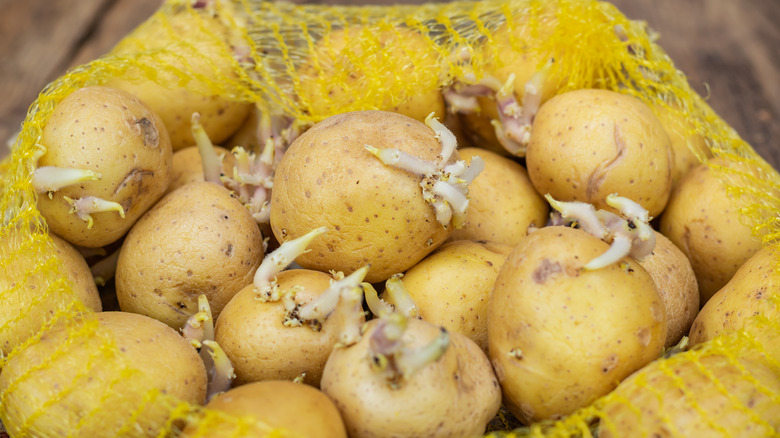Storing Apples With Potatoes May Not Be The Hack You Think It Is
The last thing you want is for your food to stare back at you, especially when the food in question is a potato. Potato "eyes," also known as sprouts, are small stems that facilitate the growth of new spuds when placed in soil. However, sprouts can also appear after potatoes have been harvested, especially when in certain storage conditions. When kept in a warm, moist area of the home, sprouts are likely to develop, as these conditions mimic the growing environment potatoes love. That means your kitchen pantry could be creating the ideal conditions for sprouting potatoes.
As for food safety, it's typically okay to eat potatoes that have sprouted, provided the offending protuberances have been removed with a vegetable peeler. However, you should check for signs that a spud may have gone bad, which include a lack of firmness, foul odors, and a greenish tint. According to Canadian health officials, green indicates that the vegetable could be harboring a toxin called glycoalkaloid, which causes gastrointestinal distress and an oral burning sensation after eating. Because most people find sprouts unpalatable, your best bet is to prevent them from developing in the first place. Proper storage is key in this regard, but there are some conflicting opinions on what exactly that entails. One of the most popular tricks is to store potatoes and apples together, but does it really work?
An apple a day keeps the sprouts at bay?
It's said that storing your potatoes with an apple can prevent sprouts from developing, while also extending the shelf life of your spuds. The key is in the ethylene gas that apples generate, which is integral for the fruit to become ripe. According to a study featured in the Journal of Food Science and Technology, ethylene reduces the rate of carbohydrate metabolism, while also increasing the respiration rate of spuds for prolonged freshness. However, storing apples with other types of produce can cause them to ripen too quickly, which can mean they spoil before you're able to eat them. As a result, the potato freshness apple hack is hotly debated.
For instance, any fruit or vegetable that produces or is vulnerable to ethylene, which includes produce like bananas, tomatoes, and melons, is stored on its own. Potatoes also produce ethylene, but have a lower overall sensitivity to the chemical. Regardless, it's still recommended that spuds are kept away from any ethylene-susceptible produce, particularly when the potato has some bruising. No matter where you fall in the apple vs. no apple debate, there are a few proven techniques that will keep potatoes fresher for longer.
Best practices when storing your spuds at home
When it comes to storage conditions, temperature plays a significant role in lasting freshness. In this case, the ideal temperature range for potatoes is 43- and 50-degrees Fahrenheit, which may help raw spuds last up to four times longer. Additionally, cooler storage conditions also ensure that potatoes maintain most of their vitamin C percentage. While cool conditions are preferred, never store spuds in a refrigerator. Very low temperatures actually cause the starch in potatoes to transform into sugar, which can develop into serious toxins once the spud is heated up again, according to Healthline. And freezing potatoes can destroy the firmness and texture due to expanding ice crystals as water inside the potato freezes.
While it's important to wash potatoes before using them, avoid washing the skins prior to storage, as doing so can lead to fungal and bacterial growth on the vegetables. By the same token, never store spuds in a sealed bag or container. Good ventilation allows air to flow freely, which ensures any lingering moisture evaporates before it leads to spoilage issues. While potato storage is not complex, using best practices reduces food waste and ensures optimal taste for this beloved side dish.


